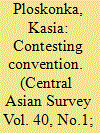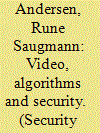| Srl | Item |
| 1 |
ID:
177713


|
|
|
|
|
| Summary/Abstract |
This article examines artistic intervention into local conventions as a means of eliciting social awareness within the current cultural space of Dushanbe, Tajikistan, in which self-censorship is commonplace. As is to be expected, the art receiving the greatest support is sponsored by the authoritarian regime, who use it as a soft tool to construct a desired or prescribed form of national identity and to project state symbols into the global arena. In contrast, artworks which are contentious in their subject matter are mainly supported through international agencies. I explore the agency and autonomy of contemporary art, notwithstanding continuing state efforts at controlling, co-opting and incorporating art into a nationalist and legitimizing narrative. By focusing on selected artworks shown in Dushanbe within the last decade, where there are only a handful of artists work in this genre, I investigate how they unpack current societal issues of women’s rights, shifting ideologies, Islamization and civic duty.
|
|
|
|
|
|
|
|
|
|
|
|
|
|
|
|
| 2 |
ID:
154750


|
|
|
|
|
| Summary/Abstract |
Digital videos increasingly sustain new and older imagined communities (and enmities), and make battlefields, unfolding terror plots and emergencies public. Yet digital videos mediate security articulations following logics that are radically different from those of journalistically edited media, with consequences for how we should think of security articulation in new visual media. This article analyses how, in digital video, the combination of visible facts and the remediation logics of algorithmically governed video platforms – such as YouTube and Facebook – allow for new types of security articulations. It argues that digital video can be understood as a semiotic composite where the material semiotics of media technologies, calculated publics and spectators combines with the political semiotics of audio-visual media to condition how video articulations work as political agency. A powerful video-mediated security articulation, the #neda videos from the 2009 Iranian post-election crisis, illustrates how security articulation in digital video is not tied to the authority of a speaker and does not contain the promise of an immediate, illocutionary security effect. Drawing on securitization theory and Butler’s critique of speech act theory, this article understands such video articulations as post-sovereign security articulations.
|
|
|
|
|
|
|
|
|
|
|
|
|
|
|
|